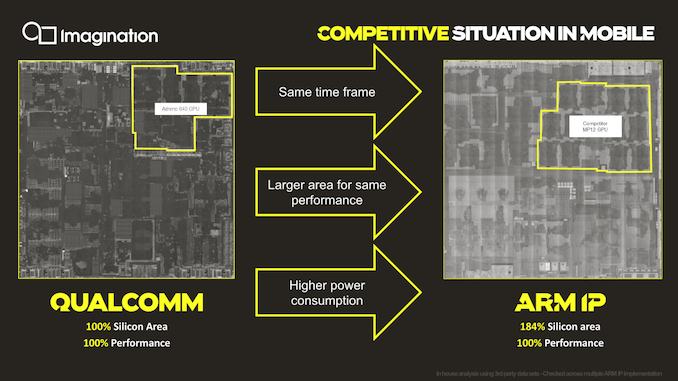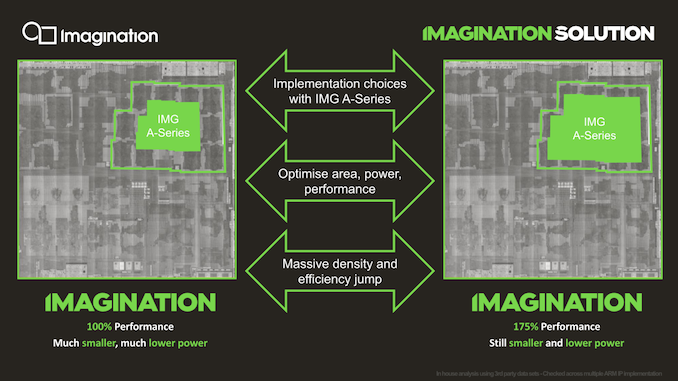Imagination Announces A-Series GPU Architecture: "Most Important Launch in 15 Years"
by Andrei Frumusanu on December 2, 2019 8:00 PM ESTPPA Projections - Significant, If Delivered
Moving on, the A-Series improvements don’t mean much if we can’t put them into context in the competitive landscape.
As mentioned in the introduction, Imagination seem aware of the current PPA deficit that GPU vendor IP offers versus custom designs by more vertically integrated SoC vendors.
Starting off with a comparison between current generation Qualcomm GPU against an Arm GPU. Imagination didn’t specifically mention which designs we’re talking about here, but we do clearly see from the die shots that the SoCs being compared are the Snapdragon 855 and the Exynos 9820.
Here Imagination describes that for a similar performance level, Arm’s Mali GPUs are using ~184% the silicon area compared to Qualcomm’s Adreno implementation.
I do have some doubts about the validity of the comparison being made here, as these SoCs were not made on the same process node – Qualcomm's design is built on TSMC's denser 7nm process, while Samsung's Exynos uses their larger 8nm process. With that in mind, we take the metrics presented with a huge grain of salt as Imagination does say the figures are based on analysis of multiple Arm IP implementations rather than a single data-point.
Projecting the A-Series against a current Mali-G76 implementation, targeting a performance level equivalent to current generation flagship implementations (~100fps in Manhattan 3.0), an A-Series GPU would achieve a significantly smaller GPU implementation requiring much less die area. The comparison implementation here would be an AXT-16-512 implementation running at slightly lower than nominal clock and voltage (in order to match the performance).
If a customer were to choose to use more die area to go wider and slower in clock (more efficient), while still maintaining an estimated area that would be smaller than a Mali GPU, it would roughly achieve a 75% performance advantage. The comparison here would be an AXT-32-1024 running quite far below nominal, giving it a large power efficiency advantage.
Of course, Imagination’s comparison here were made against the current generation Qualcomm and Arm GPUs, which aren't what it'll actually be competing against. Instead, by the time A-series SoCs ship, it will be competing against the next-generation Adreno as well as Mali-G77. We know Arm’s promised goals for the G77 and the improvements in performance per mm² and performance perf/W is around 1.2-1.4x, which we could generalize to 1.3x. Samsung’s upcoming Exynos 990 only promises a 20% performance increase, which is slightly below this projection. On the Qualcomm side and the upcoming Adreno generation, we’ll have to wait a few more days to be able to talk about details, but generally we expect improvements in the same ballpark.
Fortunately for Imagination, the projected PPA figures and advantages for the A-Series are high enough that they would still be notably ahead of both Qualcomm and Arm’s upcoming next generation GPUs, keeping a comfortable lead in either GPU area, or performance, depending on the configuration.
So far everything looks quite splendid – what remains to be seen if Imagination and their licensees are able to deliver on the projected figures.












143 Comments
View All Comments
vladx - Wednesday, December 4, 2019 - link
Lol taking the words of a shady company like Apple as a fact, good one melgrosss.s.yu - Wednesday, December 4, 2019 - link
Championing a shady company like Huawei, good one vlad.name99 - Tuesday, December 3, 2019 - link
Andrei is as close to correct as one can hope to be.All we ACTUALLY know is that PowerVR has NEVER sued Apple. They said some pissed off things in a Press Release, then mostly took them back in a later Press Release.
And Apple said it would cease to pay to *royalties* to Imagination within a period of 15 months to two years.
It is possible that Apple created something de novo that's free and clear of IMG and that's that.
It's also possible that Apple paid (and even continues to pay?) IMG large sums of money that are not "royalties" but something else (IP licensing? patent purchase? ...).
We have no idea which is the case.
Apple is large enough that the money paid out could be hidden in pretty much any accounting line item. IMG is private so have no obligation to tell us where their money comes from.
mode_13h - Wednesday, December 4, 2019 - link
Yeah, it could've been a one-time lump sum payment. That's not technically "royalties".lucam - Tuesday, December 3, 2019 - link
Very true. If you were to run GFXBENCH on the new iPhone 11PRO with the A13, you will see that the gldrivers are all powervrs and IMGtc just the previous A12. Exactly the same. So in my mind the A13 still has some form of PowerVR design in it.vladx - Wednesday, December 4, 2019 - link
Don't kid yourself, Apple tried to buy IMG Tech on the cheap and I'm glad Imagination refused their insulting offer.lucam - Wednesday, December 4, 2019 - link
To be honest I think Apple still has some PowerVR design into the current chips, even in the A13, otherwise I can't explain why it appears the GLdrivers (PowerVR, img texture text etc) when I run the GFX bench....I think Apple and Imagination still have in somehow some form of good relationship behind...
s.yu - Tuesday, December 3, 2019 - link
"ISO-area and process node comparison"Goddamn. So refreshing to see a comparison under such standard conditions yet still showing up in footnotes. This is the industry that I recognize, not Huawei's deceitful comparison during the launch of GPU Turbo with age old design and age old architecture *without* due clarification for months.
Sychonut - Tuesday, December 3, 2019 - link
Now imagine this, but on 14+++++++. A beauty.mode_13h - Tuesday, December 3, 2019 - link
> There are very few companies in the world able to claim a history in the graphics market dating back to the “golden age” of the 90’s. Among the handful of survivors of that era are of course NVIDIA and AMD (formerly ATI), but there is also Imagination Technologies.Well... if you're going to count ATI, who got gobbled up by AMD, then you might also count Qualcomm's Adreno, which came from BitBoys Oy and passed through ATI/AMD.